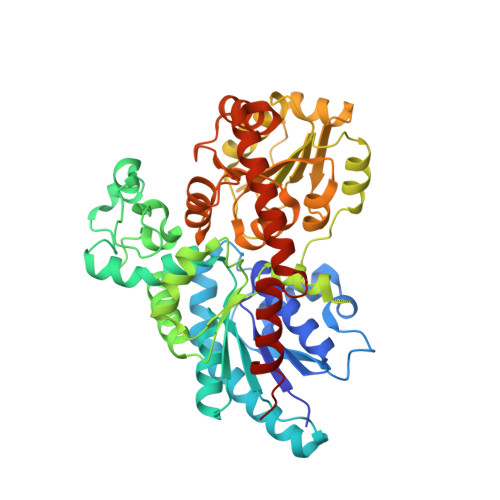Structure-guided engineering of key amino acids in UGT85B1 controlling substrate and stereo-specificity in aromatic cyanogenic glucoside biosynthesis.
Del Giudice, R., Putkaradze, N., Dos Santos, B.M., Hansen, C.C., Crocoll, C., Motawia, M.S., Fredslund, F., Laursen, T., Welner, D.H.(2022) Plant J 111: 1539-1549
- PubMed: 35819080
- DOI: https://doi.org/10.1111/tpj.15904
- Primary Citation of Related Structures:
7ZER, 7ZF0 - PubMed Abstract:
Cyanogenic glucosides are important defense molecules in plants with useful biological activities in animals. Their last biosynthetic step consists of a glycosylation reaction that confers stability and increases structural diversity and is catalyzed by the UDP-dependent glycosyltransferases (UGTs) of glycosyltransferase family 1. These versatile enzymes have large and varied substrate scopes, and the structure-function relationships controlling scope and specificity remain poorly understood. Here, we report substrate-bound crystal structures and rational engineering of substrate and stereo-specificities of UGT85B1 from Sorghum bicolor involved in biosynthesis of the cyanogenic glucoside dhurrin. Substrate specificity was shifted from the natural substrate (S)-p-hydroxymandelonitrile to (S)-mandelonitrile by combining a mutation to abolish hydrogen bonding to the p-hydroxyl group with a mutation to provide steric hindrance at the p-hydroxyl group binding site (V132A/Q225W). Further, stereo-specificity was shifted from (S) to (R) by substituting four rationally chosen residues within 6 Å of the nitrile group (M312T/A313T/H408F/G409A). These activities were compared to two other UGTs involved in the biosynthesis of aromatic cyanogenic glucosides in Prunus dulcis (almond) and Eucalyptus cladocalyx. Together, these studies enabled us to pinpoint factors that drive substrate and stereo-specificities in the cyanogenic glucoside biosynthetic UGTs. The structure-guided engineering of the functional properties of UGT85B1 enhances our understanding of the evolution of UGTs involved in the biosynthesis of cyanogenic glucosides and will enable future engineering efforts towards new biotechnological applications.
- Plant Biochemistry, Department of Plant and Environmental Sciences, University of Copenhagen, Thorvaldsensvej 40, DK-1871, Copenhagen, Denmark.
Organizational Affiliation:



















